Little World Under the
Christmas Tree
by Bob Brooke
Christmas villages have been in existence
for centuries. But cardboard Christmas houses have only been around 130
years or so. And cardboard Christmas houses made to glow from electric
light bulbs have only been around since about 1928, when electric light
strands, became affordable.
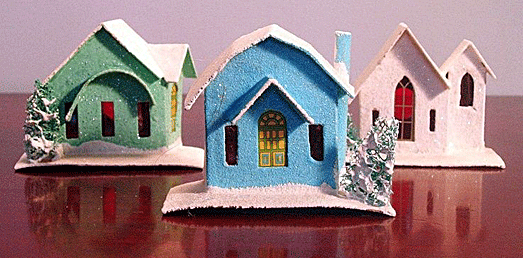
How It All Began
German-Americans began the tradition of putting little houses under
their Christmas trees in the late 19th century. They called this a
“putz” and often placed these houses around their creches.
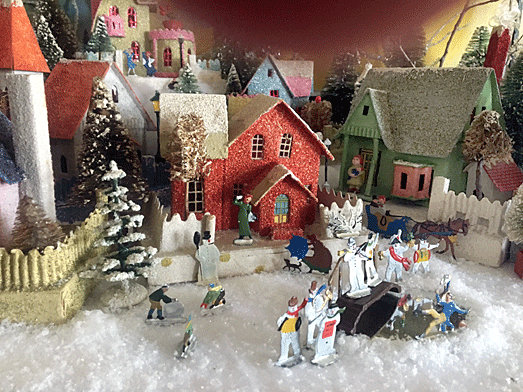
 Between
1910 and 1960, many families set houses, scenery, and other accessories
around their train sets, Nativity displays, and/or Christmas trees.
These displays paid little attention to scale or time period. It
wouldn't have been unusual to see the three Wise Men crossing in front
of a Lionel station, for example. And, in many homes, the display took
up the whole living room. Between
1910 and 1960, many families set houses, scenery, and other accessories
around their train sets, Nativity displays, and/or Christmas trees.
These displays paid little attention to scale or time period. It
wouldn't have been unusual to see the three Wise Men crossing in front
of a Lionel station, for example. And, in many homes, the display took
up the whole living room.
Between 1880 and 1928, most cardboard Christmas houses were actually
candy boxes shaped like houses that came off their bases to reveal
candies and small presents. Candy/surprise boxes took the shapes of
Santas, boots, snowmen and all kinds of things, including chimneys,
houses and castles.
But the real revolution came when Japanese manufacturers started putting
holes in the back of houses for C-6 light bulbs.
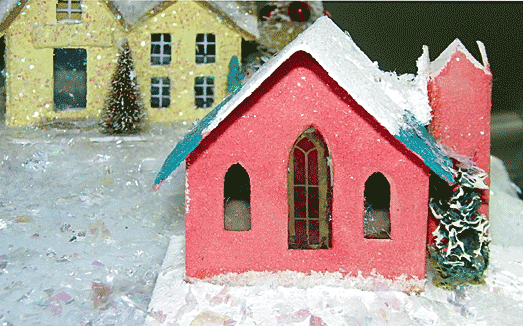
After that, there was an explosion of
variety, mostly from anonymous Japanese designers who produced some
remarkable pieces which sold for five or ten cents. But World War II
interrupted Japan’s near-monopoly on these houses. Meanwhile, American
companies like Dolly Toys created their own versions, working around
wartime limitations on materials.
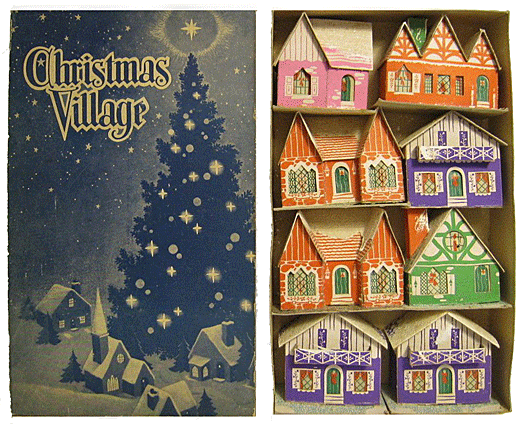
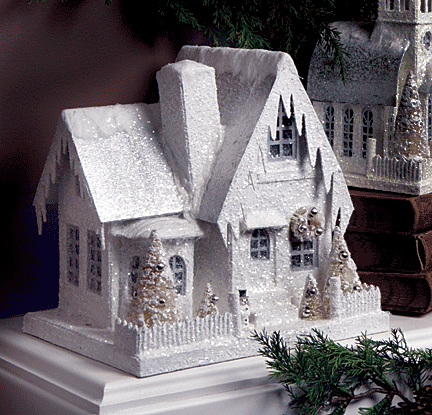 Manufacturers
made many of these inexpensive houses of pasteboard, then sprinkled them
with glitter. At first there was no sparkle but later on they did just
that. Actually, they used crushed mica not glitter. They also used
crushed shells. Some putz houses had cotton batting “snow,” while others
had a kind of coating that looked like shredded coconut. Manufacturers
made many of these inexpensive houses of pasteboard, then sprinkled them
with glitter. At first there was no sparkle but later on they did just
that. Actually, they used crushed mica not glitter. They also used
crushed shells. Some putz houses had cotton batting “snow,” while others
had a kind of coating that looked like shredded coconut.
Some of these structures had flat roofs with "parapets," which the
designers probably thought imitated Bethlehem architecture to attract
nativity-minded customers. And since many people used these little
houses with a train set under the Christmas tree, some makers produced
houses to go with toy trains.
Once inexpensive Christmas tree lights and electric trains became
available to the average family, the "candy/surprise" boxes evolved into
the electrically illuminated ones.
To accommodate the new sets of lights, both Japanese and American houses
came in sets of eight after 1928 and were sold in 5 & 10-cent and
department stores.
Printies
 Printies
had lithographed brick sides or plain colors with lithographed stone
masonry around the doors and windows. The roofs were glossy with
hand-painted snow and glitter effects. Houses had fence posts made of
wood, round, half-round or square. Sometimes makers strung iron wire
between. Bases for the printies could be either flat or a box. Many
times the same style house could be found as a candy or "surprise" box,
too. Printies
had lithographed brick sides or plain colors with lithographed stone
masonry around the doors and windows. The roofs were glossy with
hand-painted snow and glitter effects. Houses had fence posts made of
wood, round, half-round or square. Sometimes makers strung iron wire
between. Bases for the printies could be either flat or a box. Many
times the same style house could be found as a candy or "surprise" box,
too.
Gloss-Tops
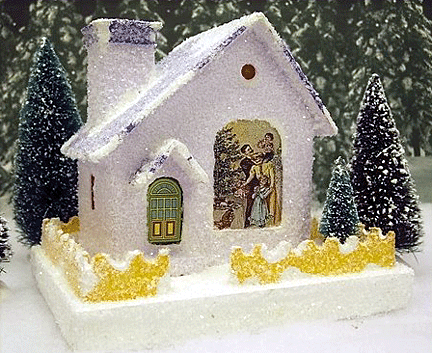 Another
variation of the Christmas houses was the Gloss-Top or G.T. They
appeared about two years after the Printies and had glossy, shellacked
roofs with the snow hand-painted over it. Shiny roofs on these houses
lasted only into the early 1930's: Shredded cellophane floss, with
painted and glittered “snow,” replaced them. Another
variation of the Christmas houses was the Gloss-Top or G.T. They
appeared about two years after the Printies and had glossy, shellacked
roofs with the snow hand-painted over it. Shiny roofs on these houses
lasted only into the early 1930's: Shredded cellophane floss, with
painted and glittered “snow,” replaced them.
 The
bodies of the large G.T.s could be squarish and blocky. Also, the big
ones seldom had fences and yard details, while the smaller card-based
ones often did. The finish of the bodies and bases was flat and lacking
in texture, except for a very fine sand. The
bodies of the large G.T.s could be squarish and blocky. Also, the big
ones seldom had fences and yard details, while the smaller card-based
ones often did. The finish of the bodies and bases was flat and lacking
in texture, except for a very fine sand.
Sets of 8, corresponding to the number of lights in a Christmas string,
continued up to the "medium" base sizes of about 5.5" by 4". Stores
sometimes sold houses of that size and larger individually boxed. They
often broke up sets and discard the flimsy set boxes as shipping
materials and set the pieces out to sell individually. Really large
houses often came individually boxed, and more of these boxes seem to
have survived.
Haciendas
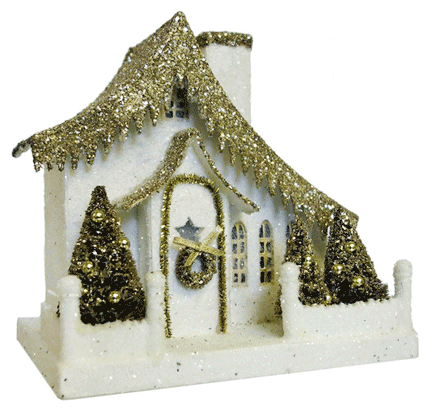 The
largest Christmas houses, called Haciendas because their hot colors and
the odd stucco portico walls, suggested an Hispanic or Southwestern
flavor. The Haciendas had varied and creative porticoed walls,
resembling adobe, painted by hand with watercolor wash to achieve a
color gradiency found on no other style of house. Also, fired bisque
figures first appeared with the Haciendas amd could be found on all but
the smallest. The Haciendas first appeared in 1935. The
largest Christmas houses, called Haciendas because their hot colors and
the odd stucco portico walls, suggested an Hispanic or Southwestern
flavor. The Haciendas had varied and creative porticoed walls,
resembling adobe, painted by hand with watercolor wash to achieve a
color gradiency found on no other style of house. Also, fired bisque
figures first appeared with the Haciendas amd could be found on all but
the smallest. The Haciendas first appeared in 1935.

Though imported putz houses reappeared after World War II, American’s
love of these little Christmas houses and the communities they created
eventually waned, when other interests, like television, consumed the
time that families used to spend setting up and rearranging the little
houses and accessories.
<
Back to Antique Spotlight Archives Next Article >
|
